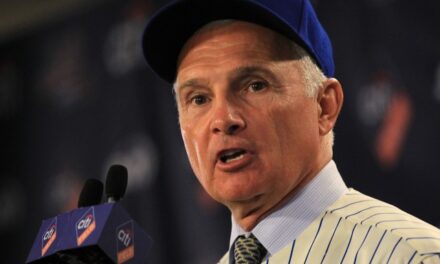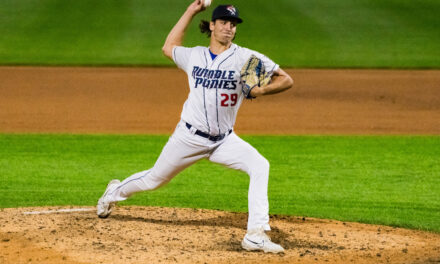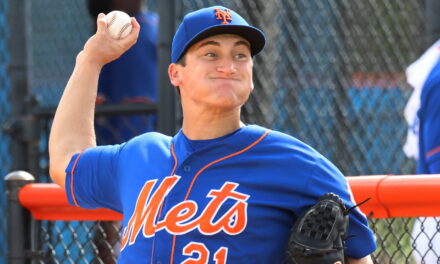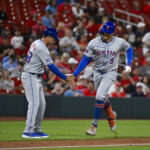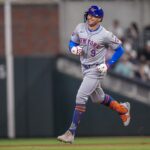
Jack Voigt played in parts of seven big league seasons with stops in Baltimore, Texas, Milwaukee and Oakland before transitioning to a coach.
He managed the Single-A Frederick Keys in the Orioles organization in 2002 before being hired in 2006 by the Mets as a scout.
From 2007 until this past season, Voigt worked as the Triple-A coach in the Mets organization and became an outfield/baserunning coordinator as well in 2011.
In his first season as coach in 2007, then Triple-A affiliate of the Mets, the New Orleans Zephyrs, finished first in the Pacific Coast League with a 75-69 record and made it to the championship round.
That season he worked with Fernando Tatis, who was making a return to baseball, spending the previous year with the Orioles after taking the 2004 and 2005 seasons off.
In 2008, Tatis played with the Mets and hit .297/.369/.484 with 11 homers and 47 RBI in 92 games (306 plate appearances).
Last season, Vegas had the top three hitters in the Pacific Coast League. Between T.J. Rivera hitting .353, Brandon Nimmo hitting .352 and Gavin Cecchini hitting.325. The batting title came down to the last day in the last at-bat at Salt Lake City.
Voigt recently worked closely with top prospects Amed Rosario and Dominic Smith, who were atop the Pacific Coast League in hitting at the time of their respective call-ups, as well as Kevin Plawecki, who returned to the Mets in August after working with Voigt and showed a big turn around.
The 21-year-old Rosario also earned the Pacific Coast League award for Rookie of the Year after hitting .328/.367/.466 with seven homers, 58 RBI and 19 swiped bags in 94 games (428 plate appearances).
I had the pleasure of catching up with the former Triple-A hitting coach last month where we talked about his philosophy as a coach and what he noticed from several players who got the call this season.
As I reflected upon my discussion with Jack, it was so apparent how deep his love was for the game, and how much he truly cares for his players.
Piersall: Minor league coaching is such an important aspect in getting players to the majors. What is the type of work you put in with hitters prior to a series?
Voigt: It’s an ongoing process. Each individual series takes on its own characteristics. It depends on the starting pitching we’re going to face, based on that team’s roster turnover they might have had from the last time we faced them.
Guys come down from the majors or up from Double-A, so we are always trying to find the information on those guys. What I try to do for our hitters is consolidate all that information down that I had access to into a very simple, straightforward form, basically based on the rotation we are gonna face.
I also carry notebooks in our dugout that have information on all the pitchers from that team we have faced during the season or even from last season. It has (information like) whether they’re right-handed or left-handed, reliever or starter, velocities on all their pitches.
I like to use hitting reports and scouting reports on my hitters more from a baseball vocabulary than from a scouting vocabulary, so I tend to use descriptive words more often than a grading scale. So, say a guy with a slider between 83-86 miles per hour, it had hard tilt and down finish late in the count and he will use it as a chase pitch. Early in the count, he uses it more as a get over slurve type.
With baseball players, we keep it really simple and then have that visual on what it was rather than try and grade it and say that it was on a scout’s scale, this guy has a 75 slider. Some guys might not understand what that is, so I try to keep it very simple.
We had access to a lot of numbers from the TrackMan and things. All the organizations, they had agreements they share with each other and then we can sometimes come up with percentages that they would use pitches more often than not. Early in the count, ahead in the count, behind in the count or with two strikes and then just give the guys the information. A lot of guys didn’t want to read it, they wanted me to verbally give it to them which was fine.
Sometimes, if a guy only threw a changeup overall average on the season let’s say six percent of the time, so six times out of 100 he’s going to throw a changeup, that didn’t mean Dominic Smith isn’t going to see five changeups in one at-bat because he was going to use it more against a left-handed hitter. So they’re percentages and they’re tendencies.
That’s all we tried to do and I tried to keep everything on line with what the guys are going to have to be prepared for at the major league level with Kevin (Long) and Pat (Roessler) based on those things so they start to understand that information more when they get there than having it thrown at them brand new.
Piersall: You were talking about Dominic Smith a little bit. Can you give me your thoughts and a little scouting report on him and Amed Rosario?
Voigt: Dom is a pure hitter. In his career, he typically always had some slow starts, but he’s always put up good numbers and come up strong. It did take him a bit of time to adjust to Triple-A, but both those guys started the season at just 21-years-old this year.
He did start to understand the philosophy and the process of utilizing his power in certain situations, against certain kinds of pitchers, he knew he was going to see a pitch he could really handle and handle well, especially some offspeed pitches middle away in the zone that he has good power to the off gap in left center and left field. He really started do that well this year.
From a hitting standpoint, Rosario, again, another 21-year-old with a lot of tools. He’s ultra aggressive with his swing, we knew that coming into the year. One of my goals was trying to get him to understand the process of being aggressively selective. You don’t want to be so selective that you are taking good pitches early in the count.
At the same time, to be selective enough that if it’s not one of your good pitches to hit early, even if it might be a borderline strike, you’re going to give yourself a better chance to catch a mistake later in the count hopefully.
Any hitting philosophy goes back even to the days of Babe Ruth and everybody else: Get a good pitch to hit and put a good swing on it, but you still have to have an understanding of the pitches you’re going to see and then focus on your strengths.
I never like to have hitters worry about what a pitchers strength was until they realize the hitter has to make an adjustment. I never want to get off my strengths.
Piersall: What kind of role does launch angle and exit velocity have on working with your hitters?
Voigt: I know those are big things that are out there now, sabermetrics and things and I buy into that and it’s a very useful tool. It does give a numerical picture on the type of hitter guys are. Sometimes though, I think we can all get caught up in numbers too much and we forget in this game, a lot of it you have to be successful with the eye test and what you see going on in the field and how guys react to things.
How do they handle situations? Is it a high stress situation? Is it late in the game? Or whether it’s a 10 run lead in the seventh inning and do they keep their focus to not give away at-bats? That’s always a phrase I use with guys is “don’t give them away. They all count.”
With all the hitters, that’s really key. Even myself in my career, just about every hitter can look at the end of the season and easily pick out a certain block of at-bats that you can sit back and admit to yourself, “Hey, I gave those at-bats away. I didn’t have a plan, I didn’t stay focused.”
Those all add to those numbers people talk about, so launch angle, exit velocity, yes they play a part, but for the big ones to do it, your 28 to 30 degree launch angle which is optimum home run power type stuff, you’ve also gotta match that with 95 mile per hour and above exit velo. Otherwise, if it’s a 70 mile per hour exit velo, it’s a pop-up to normal left field.
I think they’re good indicators, but when you look at the overall average of those numbers, and I don’t have the new ones in front of me, but I think the top players from 2016 when you averaged everything together, all the high fly balls and the ground balls, even the best hitters in the league were below 12 percent launch angle overall when you averaged everything in.
Piersall: Gavin Cecchini got called up late in the season after all the trades. What do you think of him as a prospect? Do the Mets have something in him as a second baseman and can he translate his hitting to the majors?
Voigt: I’ll tell you what. He had a really good year in 2016, he finished third in the PCL hitting .325. We had the top three hitters in the PCL last year. I was very proud of those guys. Between T.J. Rivera hitting I think .353, Nimmo hit .352 and Gavin hitting there at .325. The batting title came down to the last day in the last at-bat at Salt Lake City. It was really fun to watch and the camaraderie of the team pulling for each guy was really fun.
But Gavin this year, he really looked comfortable at second base. I wasn’t the one in charge of the infielders, my areas of the coaching were exclusively in the hitting, with some of the base running and the outfield. But just watching Gavin make the adjustment to the other side of the infield at second base at that level, he did a good job.
He’s a gamer, he likes to be out there and play and he’s got a lot of energy. It’s all up to him. Good players at some point in their career all had a prospect label, but it always comes back to that guy having to follow through with the execution. Hopefully Gavin continues to do those things and can be productive for the major league club.
Piersall: How about Kevin Plawecki? After working with you guys and coming back up, he had a really strong finish to the end of the season. What changed?
Voigt: I’m very proud of Kevin. He finally got the amount of at-bats he needed on a daily basis. As a hitter, the comfort level with knowing you are going to be playing everyday, you aren’t putting as much pressure on yourself to get a hit and make sure you’re in there the next day. Kevin works really hard. He was in the cage with me every day, he had his routines we did.
We had plans that when he came back down from the major leagues, we talked about, “OK, what can I do to help you to be the kind of player you want to be?” I want to have feedback from my hitters and we can have a plan. Sometimes that plan comes from the organization also, so we mix everything together and figure out what’s best for the player.
Kevin was able to do that. He really learned how to stay in his lower half, stay in consistent balance and put a good swing on pitches more consistently. That’s really his biggest thing. He got comfortable, he trusted his ability and he really did a great job. I’m really proud of him.
He worked hard and I can’t say enough about my guys. I’m so happy for all the guys that get the chance to get that phone call, or get that message given to them that they’re going up to the big leagues, because I had it in my career.
There’s not much better than that, when you have somebody tell you you’re going up and you’re getting to be, at that time, one of the best 750 players in the world. When you look over 25 man rosters and 30 teams, it’s an awesome feeling.
Piersall: Plawecki took that opportunity and ran with it, especially after getting that opening with all the trades and injuries at the big league level.
Voigt: You know, he was one of them, I was really happy for Travis Taijeron after putting up solid numbers the last three years at Vegas, he’s a really “grinder” type guy, goes out and plays. We all know he swings and misses, but when he doesn’t miss, he’s put up very good power numbers, RBI numbers. For us, he was always in the middle of the lineup and when he came to the plate, it could be a multi-run swing at any time.
Phillip Evans is another one. Coming off the batting title last year at Double-A, he kind of got off to a slow start this year. He and I speaking privately, he might have been pressing a little bit. Big thing with him was just to relax and stay within his ability. He’s got great, quick hands so sometimes he tries to be too quick and tries to manipulate the swing.
When he finally just let it go, one of our phrases with him was, “Just make 50 percent.” If you just make 50 percent, you’re going to be a lot closer to 100 percent and more consistent with the barrel for better contact. He was able to do that, so I was happy to see him get the call too.
All those guys though. You know, Rob, you talked about Kevin and not getting a lot of playing time in the big leagues as a backup, that’s the kind of player I was in the big leagues.
In the seven seasons I had up there from 1992-98, I was that fourth or fifth outfielder. I was that backup first baseman that would come in for defense maybe later in the game and not get an at-bat. I would face the left-handed pitching, especially in my career when the other lefties wanted a day off. Check the SABR stats, I always got Randy Johnson, Chuck Finley, Mark Langston, Jim Abbott and Jimmy Key, sometimes after not playing for a couple days.
I took it as a challenge and I tried to relay a lot of my personal experiences and how I stayed ready to these guys at the Triple-A level, over the six years I did it in New Orleans and Buffalo and then Vegas. Just staying mentally prepared even if you weren’t in the lineup, to still continue and get your daily work in, stick with your routine, so when you did get in there, you didn’t put extra pressure on yourself.
I had a lot of very good conversations with veteran players in my career.
Cal Ripken and I were in Minnesota and we were talking before the game. I think we were at lunch or something and he said, “So, you’re in the lineup tonight, aren’t you?”
And I said, “Yeah!”
He goes, “Well, you know why you’re in there, right?”
And I said, “Yeah, we’re facing a left-hander.”
He said, “What do you think about tomorrow?”
And I said, “Well, if I get a couple hits, maybe I’m in there tomorrow.”
He goes, “No, you’re not. There’s a right-hander throwing tomorrow. I hate to say that, but unless somebody gets hurt, or something happens, you probably aren’t going to be there tomorrow.
“So don’t put pressure on yourself today to get three hits, or hit a home run and drive in four that you’re going to play tomorrow, because chances are, you’re probably not. That’s not what your role is with our club here with the Orioles.”
He goes, “You’re giving somebody a day off today and in another couple days when we’re facing a lefty, you’ll give somebody else a day off. Your role is to give good, consistent at-bats, play your above average, quality defense that we all know you have, throw to the bases right, hit your cut off men and be a professional major league player.”
That stuck with me the rest of my career. It was really simple, straightforward advice that put everything in perspective for someone like myself that was that bench guy, that 23rd, 24th, 25th guy on the roster. You can’t control a lot of the things that are going to happen, but you can control what you need to control.
That’s one thing that, if I tell people, would be the thing I’d change in my career. I wouldn’t worry as much about the things I couldn’t control and just stayed focused on myself. But, that’s also what gave me parts of seven seasons in the big leagues and got me into the Baseball Almanac so I’m proud of that, and I’m proud I can relay that to the people I work with. If they’d like to use them, that’s great. If it’s just kind of a nice story to tell them when we take a break between swings, that’s good too. To me, that’s all part of coaching.
Piersall: You know Jack, you were talking to me about how you were in the majors for seven seasons and then you got into coaching. Some guys as players knew they wanted to go on to coach and would keep notebooks in their locker rooms to document the things they’ve learned to use later on. Were you one of those guys who knew they were going to be a coach?
Voigt: Yeah, I think so. It was brought to my attention early in my major league career. When I was in Baltimore in 1993, we were doing our Spring Training with Baltimore and it got late in the spring and they were setting the roster. I got called in the office and Johnny Oates, rest his soul, was the manager at the time and Roland Hemond was the GM and I sat down and both of them looked at me and said, “Well, you probably know why you’re in here.”
And I said, “Yup, when do you want me to report to minor league camp?”
And they said, “Well, before we get to that stuff, Roland wants to ask you a question.”
In his great voice that Roland Hemond has, he said, “Jack, what would you like to do when you’re done playing?”
And I said bluntly, “Well, hopefully Roland we aren’t having this discussion for another 10 or 12 years, but I would like to stay in the game. Coaching interests me and maybe managing at some point.”
They both had smiles on their faces and said, “We can see that. You’re a student of the game, you pay attention to detail, your work ethic is unquestionable. You care and you have a passion in your heart.
“We also wish you are going to be here for 10 or 12 more years, but we do need you to go down to the minor league complex tomorrow and start the season, but be ready to be called up at any time we need you. We like what we have with you on the bench and versatility with the club.”
Again, another thing from the past I used to draw on to use with players who are having a hard time to let them know I’ve been there too. I’ve been there a lot of times. I was released multiple times as a player, I was sent down multiple times as a player, I was called up multiple times as a player. It’s a roller coaster, but you can’t give up on what you feel inside.
I loved my 12 years I had with the Mets, six of them being able to help Triple-A hitters. I worked with a lot of guys who went up to help the major league club and that brings a smile to my face.

Piersall: Working in Vegas, what are the challenges of getting the guys to not swing for the fences every time they step up to the plate in such a hitter-friendly environment?
Voigt: You look at averages in stuff, it kind of depends on the team you have. 2016, when we had more of a veteran club, we were first or second in just about every offensive category. It was either us or El Paso.
This year in 2017, going into the season, we had the fifth youngest position players out of 30 teams. It wasn’t necessarily about them not swinging for the fences. This was about teaching them that this is the cream of the crop from Double-A and this is guys that are trying to refine their skills to get back to the majors.
As far as pitchers you are facing, stay within yourself and be comfortable so you can be ready for when the big league club calls you and keep that in your back pocket.
Some guys pick it up sooner rather than later, other guys it takes a little longer to get to that adjustment.
Overall, I think the guys did very well this year. We had a number of players like Xorge Carrillo who had one of his best career years and he wasn’t playing everyday. So I had to remind him to stay in his routine and stay ready so when he did get his chance, he didn’t have to do too much.
I never hit a home run in the minors when I was playing in Pawtucket because the fences were short and you try to hit it out of the park. You should actually take the opposite approach. If the fences are short, you don’t need to do extra, you just need to put a good swing on it and the ball is going to go.
Just do what you have to do. If you are a guy that gets on base, just try and get on base. If you are a line drive hitter, with occasional power while driving in 50-60 runs, be that guy.
Piersall: Do you think a lot of guys who haven’t played in Vegas come into it with the mentality of trying to hit balls over the fence too much?
Voigt: I think so, sometimes. But if you’ve never been out there, there a lot more hitter-friendly ballparks in the PCL than Vegas.
For some reason this year, it seemed Albuquerque played very short as opposed to 2015 and 2016. It just seemed this year the ball carried more there than Vegas.
Travis Taijeron might have had 32 home runs if he played in another ballpark than Vegas. Things even out and there are cheapies everywhere. Overall, your good hitters are going to be able hit though.
Piersall: Do the Mets employ a system-wide offensive philosophy? What kind of latitude does a hitting coach have when training players?
Voigt: I don’t think our hitting philosophy is any different than other teams. It’s get a good pitch and be ready. It doesn’t mean you aren’t meant to swing at a first pitch if it’s in your zone that you know you’d handle well. As a hitting guy, it means getting the barrel on it with good exit velocity.
Another good philosophy is the more pitches that are thrown, the more likely it is a pitcher will make a mistake.
A thing I tell the guys is, “There’s no rule that says we can’t hit for more than 30 minutes at a time, so let’s keep the line moving. Let’s go.”
There is a light at the tunnel, you just have to work.
Piersall: Jack, thanks so much for taking your time out to talk to me.
Voigt: Of course. I appreciate you giving me a call and giving me a chance to talk about these players. They’ve become a second family to a lot of us coaches so it means a lot.
Keep things positive on the kids coming up. There’s still some good ones on the way. There will be people that surprise and hopefully they get back to where they want to be.
Give Jack a follow on Twitter: @JVoigtBaseball


